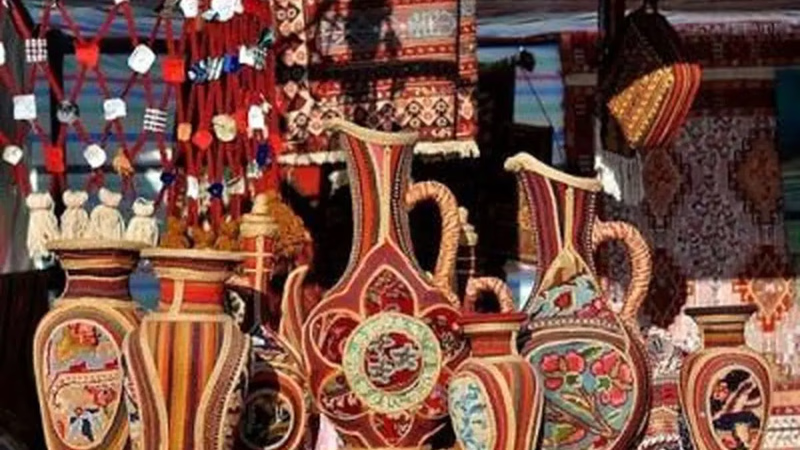
Middle Eastern handicrafts showcase artistry and cultural heritage.
The Middle East region has a rich history and culture that has led to a variety of handicrafts , including the most famous handicrafts in the world. Middle East handicrafts play a very important role in the trade of handicrafts in the world. These handicrafts are very attractive for international markets because of their beauty, quality and artistry. Middle Eastern countries, including Iran, Turkey, Egypt and Lebanon, are known as the main exporters of Middle Eastern handicrafts in the world markets. Middle Eastern arts and crafts, including carpet weaving, pottery, jewelry and metalwork, are in high demand and popularity in international markets.
The Middle East has a rich history and culture, and in addition to its unique handicrafts, they are also an attraction for tourists. Tourists who travel to the Middle East regions are interested in buying local handicrafts and strengthen this local business. Advertising and media play an important role in promoting Middle Eastern handicrafts around the world. Images and reports of Middle Eastern handicrafts in the media attract more people interested in these products and open new markets for them.
Middle Eastern handicrafts usually have patterns and designs that are related to the history and culture of the region. Geometric patterns, flower shapes and famous bates are common in Middle Eastern handicrafts. In contrast, handicrafts from other parts of the world may use their own unique patterns and designs that are related to the culture and history of that region. Middle Eastern handicrafts use local raw materials suitable to the geographical and natural conditions of the region. For example, lamb and goat wool are used in Iranian carpet weaving, and clay and local natural colors are used in pottery . In the handicrafts of other regions, local raw materials are also used, which may be different from the handicrafts of the Middle East.
The most important handicrafts of the people of the Middle East are:
- Carpet weaving is one of the most important crafts in the Middle East. Iran, Turkey and Azerbaijan are among the countries that produce very famous and high-quality hand-woven carpets. In Iran, the history of carpet weaving goes back to thousands of years BC, and hand-woven Iranian carpets known as \"Perspolis carpets\" are famous in the world.
- Pottery is also an important craft in the Middle East. Iran, Iraq, Syria and Lebanon are among the most important countries that are famous for producing beautiful and creative pottery. The city of Neyshabor in Iran is known as one of the famous pottery centers.
- Jewelry making is one of the high-quality and famous handicrafts in the Middle East. Iran, Saudi Arabia, Turkey and Lebanon are among the countries that are prominent in the production of traditional and modern jewelry. The history of jewelry making in Iran and Turkey dates back to thousands of years BC, and during this period, gold, silver and precious stones were used to make beautiful jewelry.
- Textile is one of the old and important crafts in the Middle East. Iran, Iraq, Turkey and Syria are among the countries that are famous for producing hand-woven fabrics and carpets.
- Metalworking is also one of the main handicrafts of the Middle East. Iran, Turkey, Syria and Egypt are among the countries that are famous for producing metal works of art, jewelry and decorations. The history of metalworking in Iran and Turkey dates back to thousands of years before Christ. Metalwork works of art including jewelry, decorations and metal containers are famous.
- Wood industries are also very prosperous in the Middle East. Iran, Lebanon, Turkey and Egypt are among the countries that are prominent in the production of furniture, chairs, wooden structures and beautiful wooden objects.
Middle Eastern crafts use their own techniques and manufacturing methods that are typically passed down through the generations. For example, in Iranian carpet weaving, hand-woven techniques are used, and in textiles, knitting and knotting techniques are used. Handicrafts of other places also use their own techniques and methods to make products. Cultural Symbols and Concepts: Middle Eastern crafts usually contain cultural symbols and concepts associated with the region. For example, designs such as flower blossoms, animals and religious symbols are famous in Iranian handicrafts. These symbols and cultural concepts add charm and value to Middle East products.
The countries of the Middle East continuously participate in international handicraft exhibitions and events. These opportunities allow Middle Eastern handicraft producers and exporters to introduce their products to the global market and establish relationships with international buyers and merchants. Middle Eastern handicrafts represent the culture and art of this region and have a great impact on the globalization of Middle Eastern culture and art. As ambassadors of the Middle East culture, these handicrafts strengthen cultural communication and allow other countries to get to know the culture and art of the Middle East and have a better understanding of it. The handicrafts of the Middle East not only play an important role in the local economy and job creation in this region, but are also known as the most important handicrafts in the world and play a very important role in the trade of handicrafts in the world.




